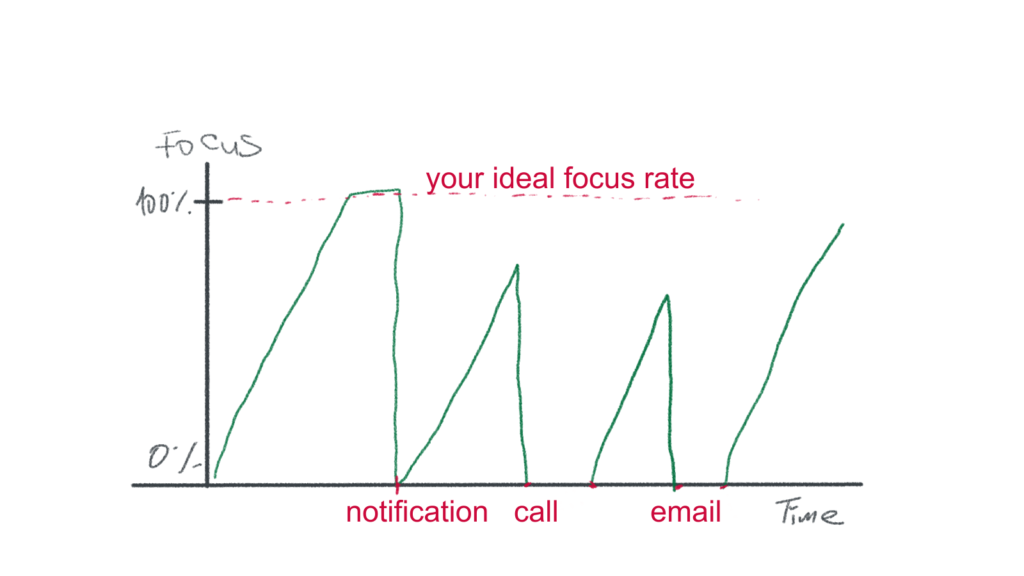Isn’t it a relaxing feeling when you can work from home? It’s a dream of many people. Being able to earn money with your laptop, from home.
Note the word relaxing, because that’s what your mind imagine behind the work from home. It doesn’t want to work, it wants to relax.
Therefore, it is imperative to develop methods, which will keep you focused on Getting Things Done.
I would like to share techniques I use daily to eject procrastination.
Step one: My personal favourite hide your smartphone!
I guess you know, that smartphone notification disturbs you when you focus on getting things done. If you can feel that, it went already too far.
When I turn my smartphone into silent mode, it can’t disturb me, right? Wrong.
Study shows, that the mere presence of a smartphone reduces brainpower available for the task.
McCombs School of Business performed an experiment with almost 800 students to measure, how well can they complete tasks when their smartphones are close, while not being used.
Researchers asked study participants to take a series of computer-based tests that required full concentration to score well. The tests were aimed to measure their brain’s ability to store and process data. Prior to the test beginning, they were asked to:
A. put their smartphones on the desk
B. put their smartphone in the pocket
C. put their smartphone in another room
All phones were switched to silent mode. The punchline was that in all tests, participants with C smartphones in another room have significantly outperformed participants B, and slightly outperformed participants A.
This research clearly demonstrates that to switch your phone into silent mode isn’t enough.
My personal trick is to switch it to the airplane mode and hide it somewhere where I can’t see.
Remember that thinking of not thinking about your phone requires your concentration too.
Step two: Get rid of notifications.
Your smartphone is trying to entertain you with all those “important notifications and emails. In fact, most of them are usually not important at all.
Those notifications are:
- disturbing your workflow, because you need to shift your focus to your cellphone. After the notification was checked, and you have realized that it’s not important [as that previous one], and you will return to your work. However, you have to build up your concentration from zero. Once you are fully focused, here it comes, the third notification.

My trick is to:
- uninstall Facebook app [to prevent me from scrolling], so I can access it only from my laptop
- Block all notifications [also Whatsapp, Messenger, Instagram, Linkedin etc.], so you will check your networks when you need, not when the apps want you.
- Airplane mode. My phone is in airplane mode all night and during my 9-5 job. I am leaving it also in a different room. This might feel like a rapid cut, but give it a week and you will love it!
- Be immediately reachable only by call and SMS. If people really need you, they will call you. If they only text you on social media, it’s not important enough.
- Schedule your social time. Check your emails and social media once a day. People who write to you here, usually don’t require immediate attention. Time block your social media time. Once the alarm rings, social media time over. Remember: Social media are like pancakes. More oil you put on the pan, the more oil they soak in.
Step 3: Time blocking and mini commitments
This is well known technique, so I will describe it only briefly.
Time blocking means that you assign time in your calendar to do certain task, so you will focus only on that task from the beginnig of that window till the end of it. If your task takes longer than your time window to accomplish, you will create another window.
Only this is usually not enough to keep you behind the laptop for 60 minutes straight. When you realize that you still wander back and forth between your shopping cart and Instagram feed, you need to get serious.
Mini commitments technique
Just imagine your dream life. Do you have a crystal clear vision about your life?
Yes?
Good. It requires to accomplish plenty of smaller tasks, then bigger tasks, then even bigger ones, so you can make your dream come true.
If you want to achieve your big dream, you need to be committed. But what if you can’t succeed in your small daily tasks? Is there any chance of your dream coming true?
If you want to create a passive income, but you are unable to add 10 products on your website when necessary, what is the chance of having a passive income?
Therefore, it is imperative to succeed in every micro commitment you make. No matter how stupid that commitment is.
When you succeed in micro-commitments, it will give you the courage to tackle bigger ones.
Step four: Active breaks
Nobody can be effective behind the laptop for 6 hours straight.
Doing so will only drop your productivity rate every next hour. It’s not about how much you sit behind da laptop, it’s about how much ya create.
Work max 3 hours in one push, then do some activity. Work the next 2 hours, then lie on the grass under the sun for example. Work the next 2 hours then do the cooking…
Try to Make More, Work Less

Then go to sleep in the forest, just because you know it at home too well:-]
Step five: Tidy up your inbox
Thousands of emails in your inbox are your enemies. My girlfriend is fighting 3000 of them.
My inbox has zero. Unless I have a task to complete.
A full inbox is confusing and frustrating. You are getting lost with tasks that need to be done, then you fail to execute them. I had this problem when I worked as a crane electrical engineer. I was notorious for this. My inbox had 800 items and I wast lost in it.
Then I’ve read this book and my professional life’s changed. Getting Things Done
Now I work this way:
- When I receive an email, I decide what to do about it right away. Therefore, I don’t need to use my brain for the same task again.
- If it needs less than 2 minutes to solve, I do without delay.
- If it needs more, I leave it in the inbox. This is my reminder to do something about it.
- If it’s done or doesn’t need any action, I move it into the archive.
- If it’s unimportant it goes to the bin.
- When the decision was made, it’s over. I don’t re-think it.
- I unsubscribe from everything that’s not relevant, instead of deleting email from the same newsletter every second day.
Step six: Perfection kills result
Do you wan’t to be perfect? Great, me too. But what defines perfection? How many hours does it takes to create perfect article or project?
This was my biggest problem when I worked as an ebike specialist, and I still fight it.
When I want to fix the bike “perfectly”, it takes me 7 hours, while to make it Good Enough it takes only 2. The difference? Customer’s never noticed.
However, if I do it perfectly, and I say it’s perfect, imperfection can be found.
Is it worth to save 5 hours of my time? You bet.
When my boss gave me a project to do, it was the same story. I’ve tried to impress him, so I worked my ass off. Once he received my “perfect outcome”, he said, I think you should change the direction of this project. “This is not what I want”.
“What?!” My head spun 360 degrees, while my mouth transformed to a flamethrower.
Wouldn’t it be better to send him a concept first? Wisely, that’s what I do now.
This blog post is not perfect either, but it is Good Enough.
The last 10 percent of a perfect project, often takes 50 percent of the time.
Go for Good Enough instead of Perfect.
Quantity creates Quality
If you are creating content like me, the worst thing to focus on is quality. It might sound strange, but if you keep posting quantity, the quality will follow.
Focus on quality first, and you will be stopped by an early imposter syndrome.
Having an imposter syndrome doesn’t mean that you are a beginner writer. Worldwide known author Stephen King, for example, was known by having gargantuan imposter syndrome in late years of his writing career. Even when the others thought his book was amazing, he thought it sucked.
The best way how to keep creating progressively better content is to focus on quantity.
There will be always 50% of your content below average and 50% above. Create more and you will have more above average content.
And while having some spare time, work on yourself. There are some fascinating books for ya! https://defeatyourlimits.com/library/




